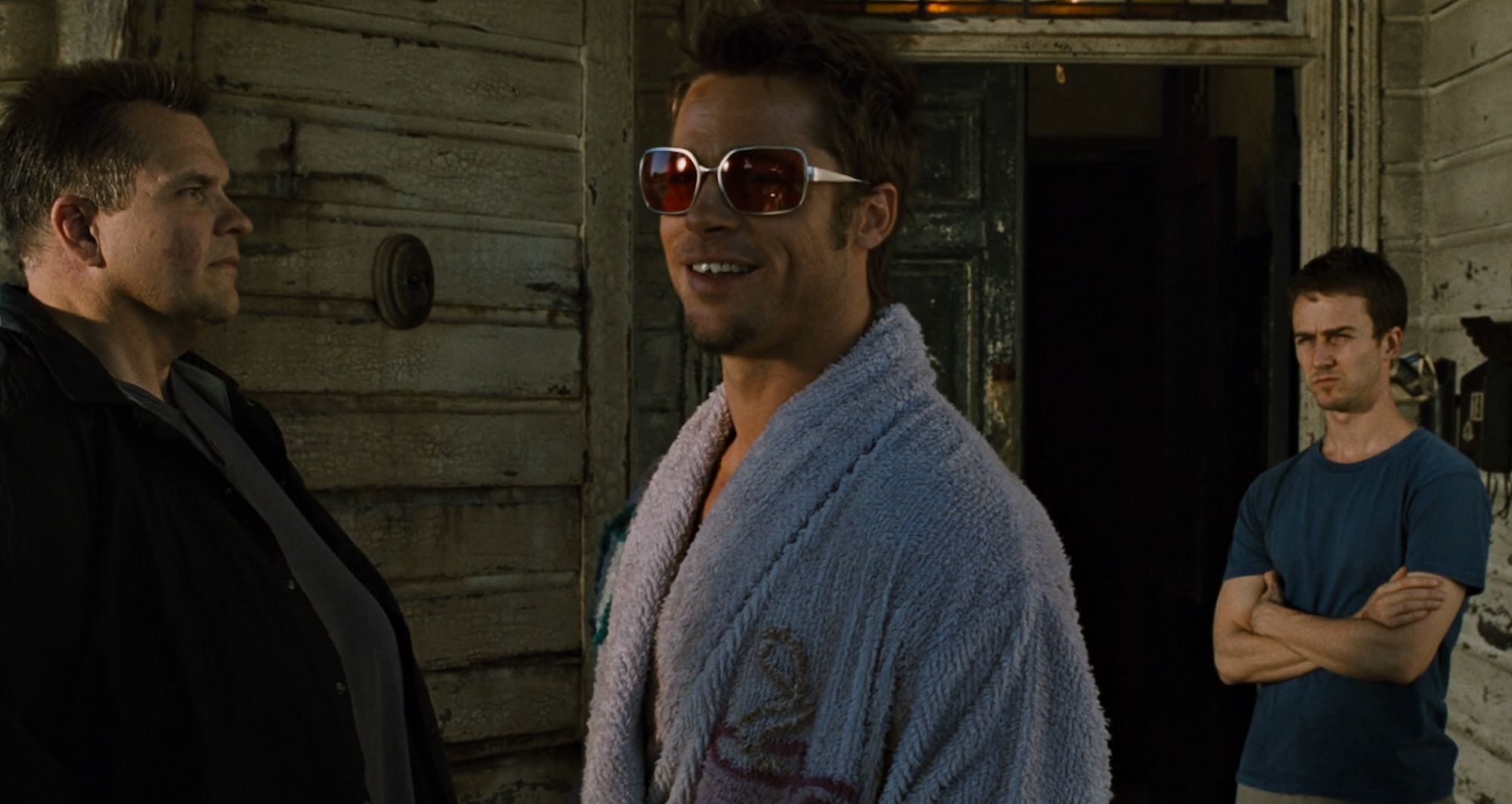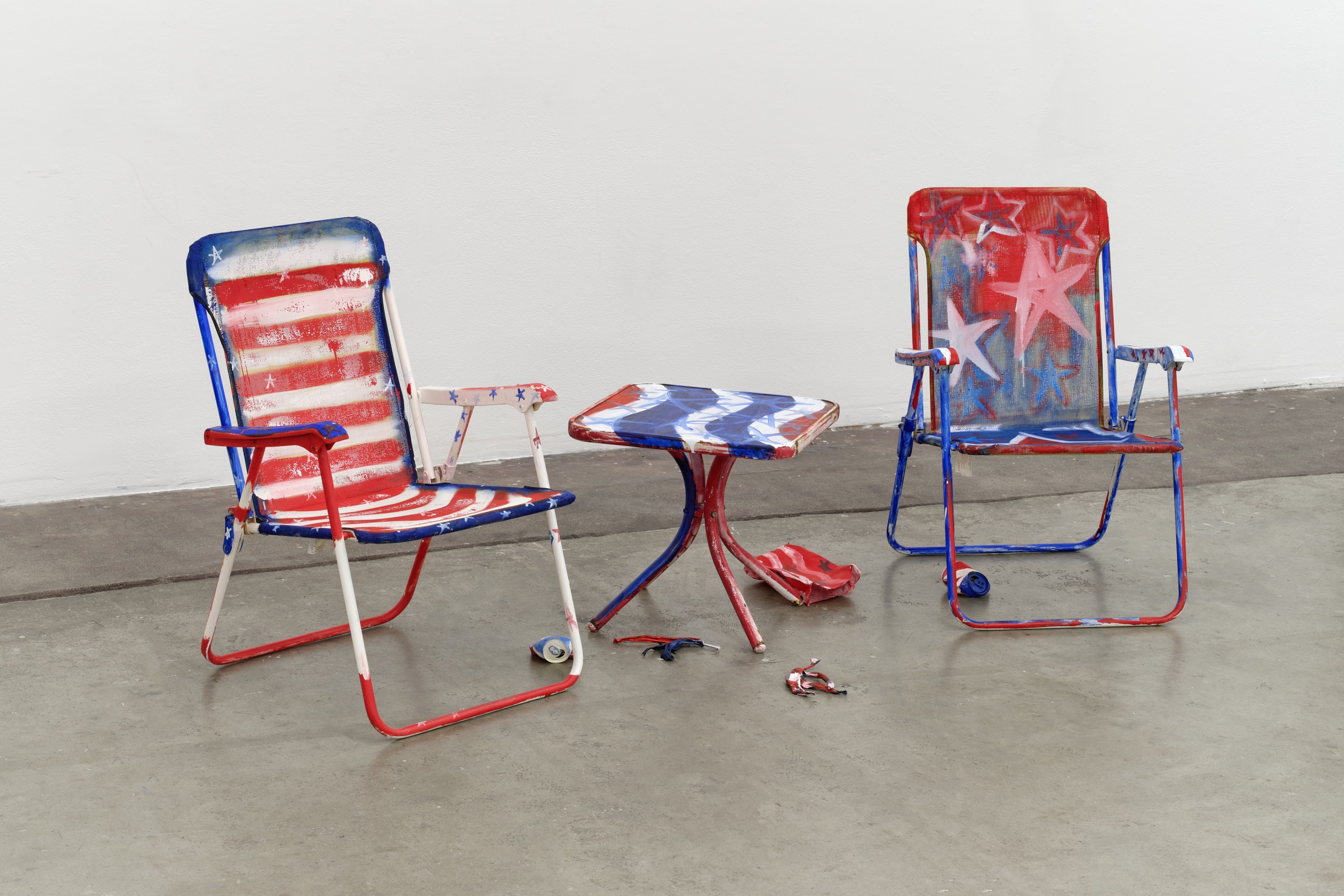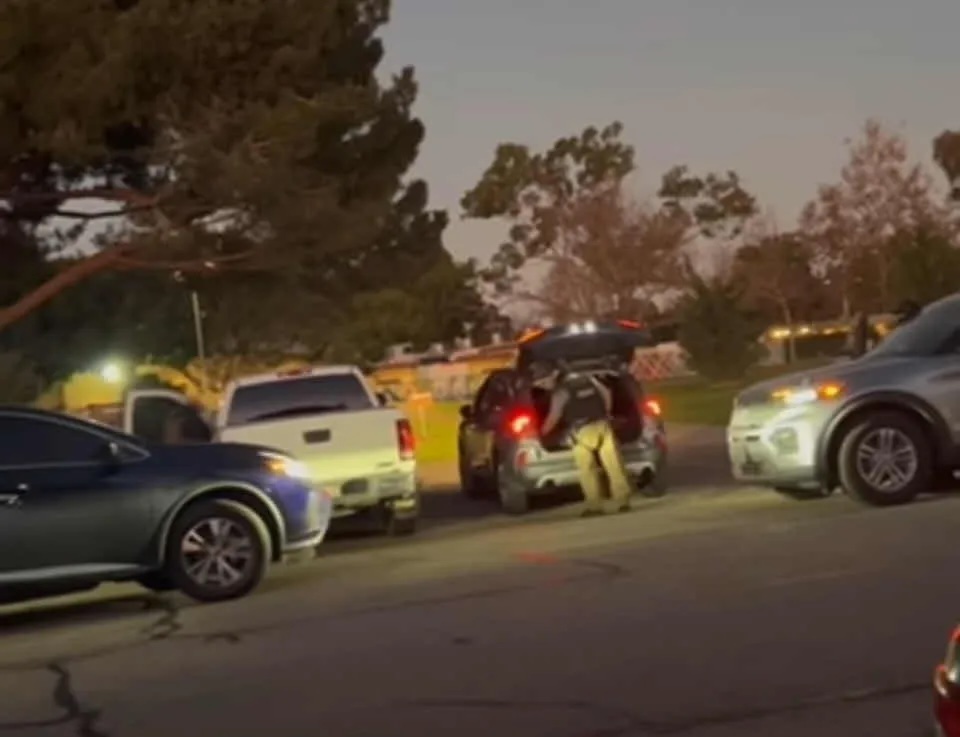The first rule of this article is… do not read further unless you’ve seen Fight Club.
The second rule of this article is… DO NOT READ FURTHER UNLESS YOU’VE SEEN FIGHT CLUB.
Ok, now that the twenty-five-year-old spoiler warning is out of the way…
It’s a beautiful Sunday morning in Wilmington Waterfront Park, just on the edge of the Port of Los Angeles. I cross paths with a couple of people riding bicycles; occasionally someone passes by walking their dog. Now and then a few semi trucks turn onto Harry Bridges Boulevard, but overall it’s pretty quiet; it’s nothing like a weekday when the Port is in full swing.
Amidst sculptural street lamps and pedestrian bridges, manicured, grassy fields, and Brutalist-inspired park benches, it’s hard to imagine that this spot was once the site of a film set that was the antithesis to everything that now stands in its place.
When location manager Rick Schuler was scouting locations like Wilmington (Los Angeles, not Delaware—you’ll see what I mean) for 1999’s Fight Club, he says his Thomas Guide would rest between his waist and the steering wheel while driving around town.
“Finding locations really came down to the business of doing the hard work,” Schuler tells L.A. via phone from his home in Hawaii, with which he fell in love after working on a recent project there.
He adds, “I’m intrinsically curious, and I love architecture and photography and how the landscape changes as the sun either comes up or goes down.”
There’s a sense that Schuler is driven by the excitement of a new find, just like his professional career shifted 180 degrees in the late ‘80s when he left a steady teaching job to get into the unpredictable industry that is entertainment. It’s not lost on me that the career change feels analogous to that of Fight Club’s narrator and protagonist (Edward Norton), an apathetic automobile recall coordinator and insomniac—dubbed ‘Jack’ in the screenplay—who turns into an anarchic social terrorist by way of his flashy, confident and sociopathic alter ego Tyler Durden (Brad Pitt).
Schuler was recently invited to join the Production Design branch of the Academy of Motion Picture Arts and Sciences. Throughout his 35-year career, he has worked with the likes of Tarantino (Schuler calls Once Upon a Time… in Hollywood his “magnum opus”), Spike Jonze (Adaptation, Her), and Bradley Cooper (A Star Is Born). However, his relationship with visionary and boundary-pushing director David Fincher has proven to be the most fruitful.
Schuler first connected with Fincher while doing television commercials for Propaganda Films, a prolific production company co-founded by Fincher that started in commercials and music videos before producing feature films.
Fight Club was the third consecutive Fincher film on which Schuler worked, having already done both Se7en (1995) and The Game (1997) back-to-back. And yes, Schuler found and first photographed the Lancaster location from Se7en’s infamous box scene. He’s worked on almost every one of Fincher’s movies.
But of all of Fincher’s films, it’s Fight Club that is a bonafide cult classic.
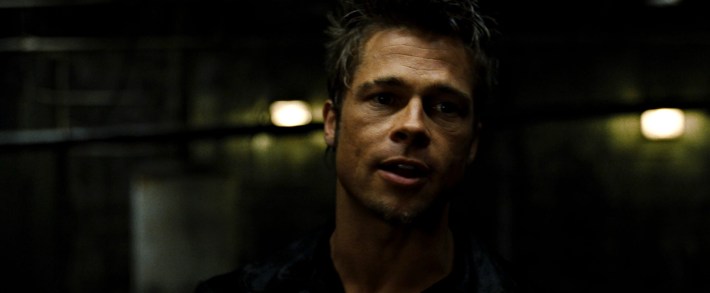
Admittedly, Schuler didn’t totally identify with the film at first. (He says the book on which the film was based really grabbed him though.) But he eventually saw how a certain generation of moviegoers gravitated towards the movie.
“My son, who’s 31, it’s like his all-time favorite movie,” says Schuler. “I’ve run into Millennials, in particular, where this movie speaks to them in ways that I don’t quite understand.”
Fight Club was released on October 15, 1999, after a September 1999 midnight premiere at the Venice Film Festival, where it was met with boos.
Based on the novel by Chuck Palahniuk, the film spoke to the Y2K scare in real time, and it brutally skewered the inherent greed of large corporations. (Ironically, it was produced by a large corporation - Twentieth Century Fox.) Some of its dialogue was shocking - “I haven’t been fucked like that since grade school” - and much of its imagery was raw and ultraviolet.
After The Game, which was set in and largely shot around San Francisco, Fight Club was a return to a highly-textured and somewhat anonymous urban environment akin to that of Se7en.
“The ‘ND,’ the nondescript city, I just love that because you can make it whatever you want, basically. There’s more freedom to it,” says Schuler.
The cities of Se7en and Fight Club were both shot in the L.A. area, but Fight Club’s themes of social class separations and blind consumerism meant expanding upon the soul-crushing neo-noir setting of Se7en.
“On Fight Club, we could go from this gritty area to the Twin Towers in Century City, and have that juxtaposition,” says Schuler. “So, for me, L.A. just has a kaleidoscope of stuff if you dig deep enough.
Fleeting visual references on newspaper dispensers and TV news reports place Fight Club in a town called Franklin. Sure, Franklin could be anywhere, but initially the location was meant to be fairly specific.
In an April 1998 draft of the screenplay, Jack says he lives in Wilmington. Presumably he’s talking about Wilmington, Delaware, as he goes on to reference credit card company headquarters, of which there are a number in Wilmington, DE because the state has business friendly laws that allow the banks to charge almost any rate of interest. A consumer is typically bound by the interest rate of the credit card company’s home-base jurisdiction regardless of where the consumer lives. These elements play into the developing plot both directly and indirectly. But Jack’s Wilmington line isn’t in the final film. There are, however, existing pieces of dialogue that reference real small towns along the Delaware River near Wilmington.
Additionally, Internet sleuths have honed in on car license plates seen throughout the film. While they appear generic, they are of the same color scheme as a style of Delaware plates.
Even someone in marketing at a label company was hip to the film’s Delaware references. In the afterward penned for a later edition of his book, Palahniuk wrote about a sample address once used on the packaging for some Avery Dennison shipping labels: Tyler Durden in Wilmington, DE.
Some descriptions in the novel, on the other hand, suggest that the characters reside elsewhere. Palahniuk, a Washington state native, writes about luggage being inspected on a runaway at Washington Dulles airport in Virginia while the main character is flying west to his destination, where he cabs it home. He also has to connect in Stapleton. Stapleton International Airport closed in February of 1995 - a year-and-a-half before the novel was first published - and was replaced by Denver International Airport.
But both the novel and the film employ a singular, visual anchor that could plausibly place the novel in the Pacific Northwest and the film on the East Coast.
Tyler Durden’s ramshackle, three-story house on the edge of town, to where Jack (Joe in the novel) moves after his IKEA-clad condo blows up, sits on Paper Street, presumably named for the nearby paper mill.
Paper production is certainly a known source of industry in the Pacific Northwest. Delaware also used to have its fair share of paper mills including what was the nation’s oldest, which started operating in 1789 and closed in the late 1990s.
Palahniuk writes of “The fart smell of steam from the paper mill” that permeated the house and neighborhood.
While there are some paper producing companies in the L.A. area, where Fincher was going to shoot Fight Club, the screenplay by Jim Uhls set up the house with a specific juxtaposition in mind:
“An abandoned PAPER MILL sits on one side [of the street] and only ONE HOUSE on the other, the rest of the land being undeveloped grass and weeds. It's an old, grand, three-story gone to seed. It looks abandoned, too.”
The novel’s main character also describes the setting as “the perfect house for dealing drugs because a bah-zillion trucks drive down Paper Street everyday, but at night, Tyler and I are alone for a half mile in every direction.”
“Before getting to the house, it’s really trying to find the environment first,” says Schuler of the film’s central location. “So, it’s gritty, it’s run down, but I need to have a paper mill nearby and it’s kind of deserted, too.”
Schuler had in his mind that he wanted to find a Victorian home, which our collective cinematic consciousness typically goes to when thinking about the house on the edge of town or the neighborhood haunted house. He spent a good deal of time looking at the turn-of-the-century homes in Angelino Heights.
“I looked for the house just in that area because I couldn’t think of anywhere else,” says Schuler.
The search proved futile, and Schuler presumes that it would have been too expensive at the time to composite the paper mill into the background of the house using CGI.
But Schuler was on a quest, and Fight Club spans so much of Los Angeles. From the seedy Hotel Bristol in downtown to the gleaming Barneys New York department store in Beverly Hills (that closed in early 2020), Fight Club not only digs deep; it’s granular in terms of locations. For as many anchor locations featured in the film, there are just as many that appear on screen for only a few fleeting seconds. And amidst some of the city’s old reliables - LAX, the Ebell of Los Angeles, the Millennium Biltmore Hotel - Fight Club employs a handful of dynamic, offbeat locations. There’s Lou Ehlers Cadillac, a mid-century modern car dealership on Wilshire Blvd in the Miracle Mile (demolished in 2008) that was used for the sequence in which Tyler Durden tells the members of Fight Club to start a fight with a stranger… and lose. Or Melrose Ave just a few blocks west of Vermont where the camera plays almost 360 degrees as Jack and Marla (Helena Bonham Carter) cross the street and enter and exit various buildings. And just when I thought the production hadn’t used any locations north of Hollywood, Schuler tells me that the film’s rainy, nighttime car crash sequence was shot along Foothill Blvd. in Sunland, outside what is now Angeles National Golf Club.
It was upon the casting of this wide net and the Thomas Guide again at his hip that Schuler ended up around the Port in Wilmington (Los Angeles, not Delaware - you get it by now). But he wasn’t there looking for the house.
“I found Lou’s Tavern first,” says Schuler. “I knew that location and that just fit the bill.”
The location had previously appeared in William Friedkin’s To Live and Die in L.A. (1985).
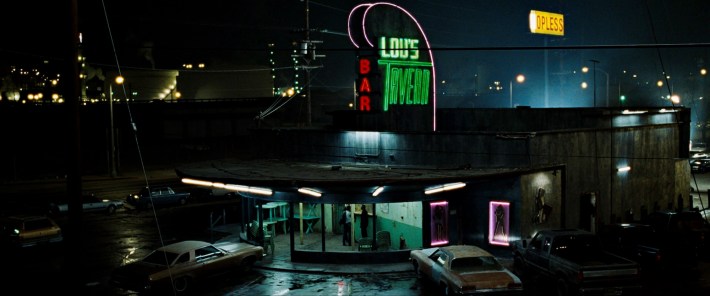
Lou’s Tavern, where the first Fight Club was formed, was a shuttered truck stop called Shipwreck Joey’s. The location had a history going back to the 1940s, when it opened as a 24-hour drive-in cafe that was conveniently located for truckers and Port employees. It eventually turned into a nightclub featuring live music acts before becoming a strip club and finally a truck stop.
“At the time, it was just a storage unit for hazmat oil and huge barrels that were inside,” says Schuler. “The guy living there had dogs that he put on the roof that he didn’t feed, and they would eat their own excrement. It was a mess, but the bones of the location were amazing.”
The building was shuttered permanently in 1998 when it was purchased by the Port as part of a planned buffer zone between the Port and the adjoining neighborhood. The building was demolished in 2000.
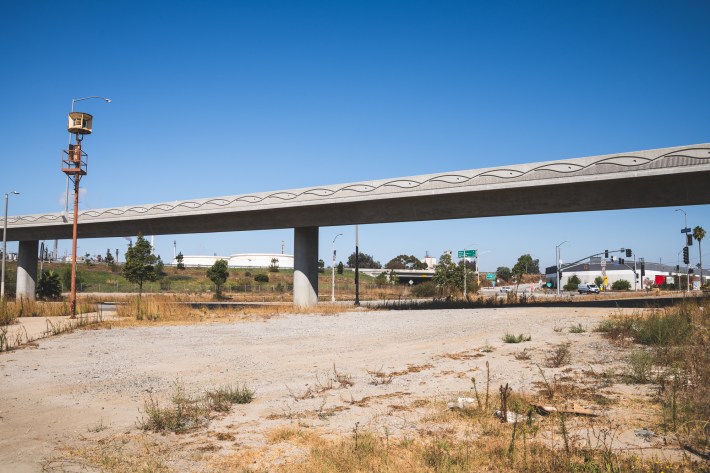
Schuler found a couple of other locations in Wilmington, too. The North Star liquor store, which is no longer standing, was a few blocks away from Shipwreck Joey’s. A tire shop on Avalon Blvd was used in the aforementioned “start a fight” sequence.
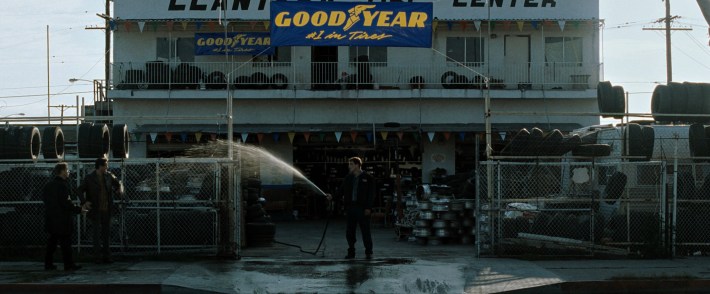
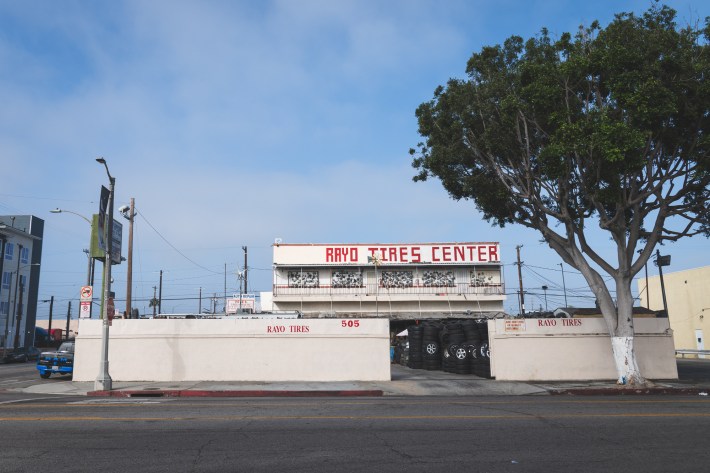
Schuler recalls, “Eventually what happens is I’m scouting down there, and I see a generating plant with two smokestacks on it and I’m like, ‘Ah, here’s the paper mill.’”
But there were no Victorian-style homes near the Harbor Generating Station. Most of the houses in the neighborhood are single-story tract homes from the early 1950s.
There was, however, a big parking lot with a chain link fence around it that was owned by the Port. The land had a good view of the smokestacks.
“It was on the edge of society,” Schuler recalls.
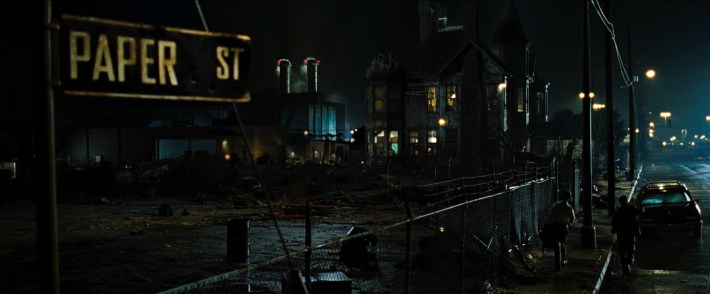
IMDb lists the location as 240 N Neptune Ave, which is currently a fenced-in parking lot that sits on the northeast corner of Neptune Ave and C St. But that’s simply the closest existing address. The lot actually sat on the east side of Neptune Ave between C St and Harry Bridges Blvd, when Neptune Ave ran through what is now Wilmington Waterfront Park. That block was part of the Port’s major land acquisition and expansion project that had been in the works for years. Plans for a mile-long, 20-foot high sound wall was initially conceptualized for this area to help mitigate noise - especially for the residents near C St - emanating from Harry Bridges Blvd. That proposition was scrapped when Wilmington residents instead fought for a park that would act as a “landscape buffer”. Construction on the 30-acre park, which features a 16-foot high grassy landform to block noise, began in 2009 and was completed in May of 2011 at a cost of $55 million.
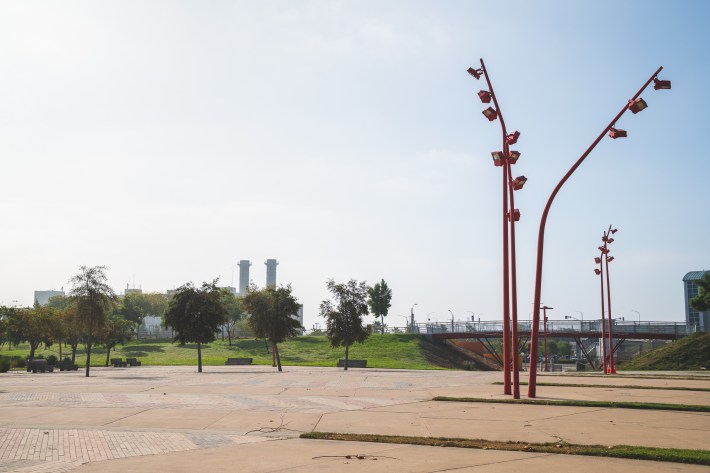
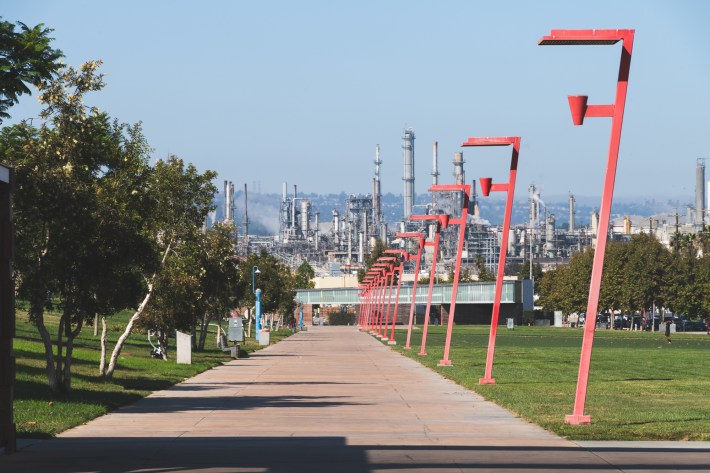
“The Port was not what it is today,” says Schuler of scouting the area for Fight Club. “It was a neighborhood that was just sort of dotted with buildings here and there, so it really felt sort of abandoned. The roads were kind of rough, not nicely paved."
Schuler somehow managed to get through the fence and onto the lot itself. He photographed the location at night to capture the atmosphere for Fincher. Pools of light emanating from the lamp posts were visually captivating, he remembers.
Upon showing Fincher the photographs, Schuler says that the director took interest in the elements that he himself initially found compelling.
“And then David basically turns to me and goes, ‘So you want us to build it here?’ I’m like, ‘Yeah, that’s what I was thinking,’” Schuler says, cracking up at the memory. Fincher could not be reached for comment for this article. “David had never said he wanted to build this house, but I was like, well, here’s the paper mill; now I have all the trucks going by,” Schuler adds.
“I was lucky that we were there at a time where the intended use had not caught up with the dates that we wanted to be there, so we were free and clear to do what we wanted to do,” says Schuler.
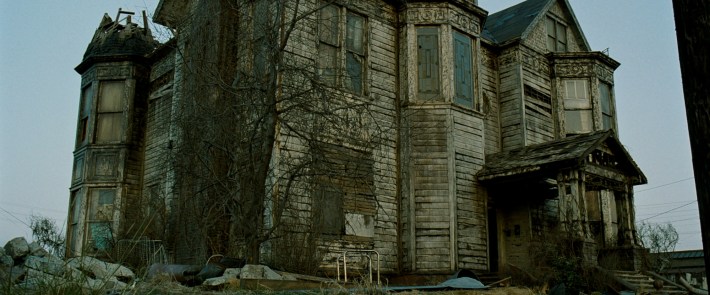
The house took a couple of months to build.
“It looked real, and it looked like it belonged there,” says Schuler. “From what I remember it was finished on all four sides.”
The impressive set piece was in a class of iconic constructed movie houses that came before it like the Farmer’s house from Days of Heaven (1978) and the Maitland’s house from Beetlejuice (1988).
One day, a passerby expressed some concern that the ramshackle home wasn’t up to snuff.
“This one guy came by going, ‘Hey, I gotta tell you, they’re skimping on stuff,’” says Schuler. “I’m like, ‘It’s not a real house; it’s just a set for a movie.’”
When Schuler first saw the location, he correctly assumed that the weathered and dilapidated interior of the house would likely be built on stage to afford the filmmakers the flexibility to shoot the myriad of action that took place throughout its rooms and corridors.
Production designer Alex McDowell also could not be reached for comment, but at a 2016 screening of Fight Club, he told an audience that most of the ground floor, the entire upstairs and the basement, which had to be flooded, were built on separate soundstages.
The kitchen, however, was filmed on location inside the constructed house, as it had to open up to a backyard garden, where Tyler’s army of unwavering disciples and executors of Project Mayhem, the Space Monkeys, were growing herbs to make homemade soap for the Paper Street Soap Company.
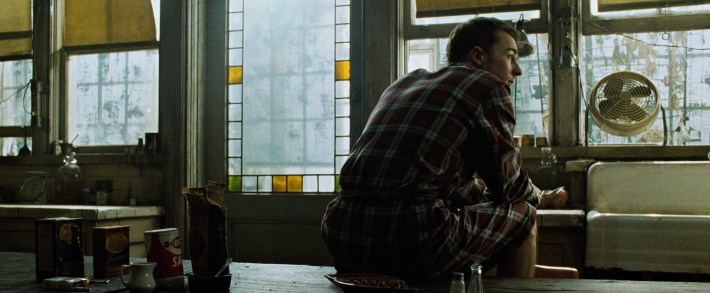
Ultimately, the Paper St house is a physical manifestation that reflects the mental anguish and conflict of Fight Club’s main character. When Norton approaches that solitary house of rotting wood and boarded up windows, we are seeing him walk into his distressed brain.
Following the release of the film and over the course of subsequent years, Schuler says that people have often asked him where the house was, not simply out of personal interest, but also with the possible intent of using the location.
“If you work in commercials, these commercial directors would reference Fincher all the time. He became like the go-to as far as images [are concerned] for a lot of stuff,” says Schuler. “Whatever he did, people were watching it very carefully and wanted to duplicate it."
The response to the whereabouts of Tyler Durden’s house is always the same: “There is no house.” Schuler says, “They’re flabbergasted to think that we would build a whole house right there on the edge of a parking lot.”
The house was completely dismantled after filming and the location was returned to a vacant lot with port authority signs affixed to the chain link fence.
While Schuler is admittedly somewhat nostalgic towards the locations that no longer exist in Wilmington, he says there is a plus side, especially when it comes to a director whose work has been often imitated.
Schuler says, “At some level, it’s exciting to know that Lou’s Tavern and the liquor store and the place where we shot the house are not there anymore because nobody could duplicate it. It couldn’t be seen in another movie.”
